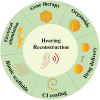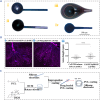Emerging biotechnologies and biomedical engineering technologies for hearing reconstruction
- PMID: 39188297
- PMCID: PMC11235852
- DOI: 10.1002/SMMD.20230021
Emerging biotechnologies and biomedical engineering technologies for hearing reconstruction
Abstract
Hearing impairment is a global health problem that affects social communications and the economy. The damage and loss of cochlear hair cells and spiral ganglion neurons (SGNs) as well as the degeneration of neurites of SGNs are the core causes of sensorineural hearing loss. Biotechnologies and biomedical engineering technologies provide new hope for the treatment of auditory diseases, which utilizes biological strategies or tissue engineering methods to achieve drug delivery and the regeneration of cells, tissues, and even organs. Here, the advancements in the applications of biotechnologies (including gene therapy and cochlear organoids) and biomedical engineering technologies (including drug delivery, electrode coating, electrical stimulation and bionic scaffolds) in the field of hearing reconstruction are presented. Moreover, we summarize the challenges and provide a perspective on this field.
Keywords: drug delivery; electrical stimulation; gene therapy; hearing reconstruction; organoid.
© 2023 The Authors. Smart Medicine published by Wiley‐VCH GmbH on behalf of Wenzhou Institute, University of Chinese Academy of Sciences.
Conflict of interest statement
The authors declare that there are no competing interests.
Figures








References
-
- Meena R., Ayub M., J. Ayub Med. Coll. Abbottabad 2017, 29, 671. - PubMed
Publication types
LinkOut - more resources
Full Text Sources

